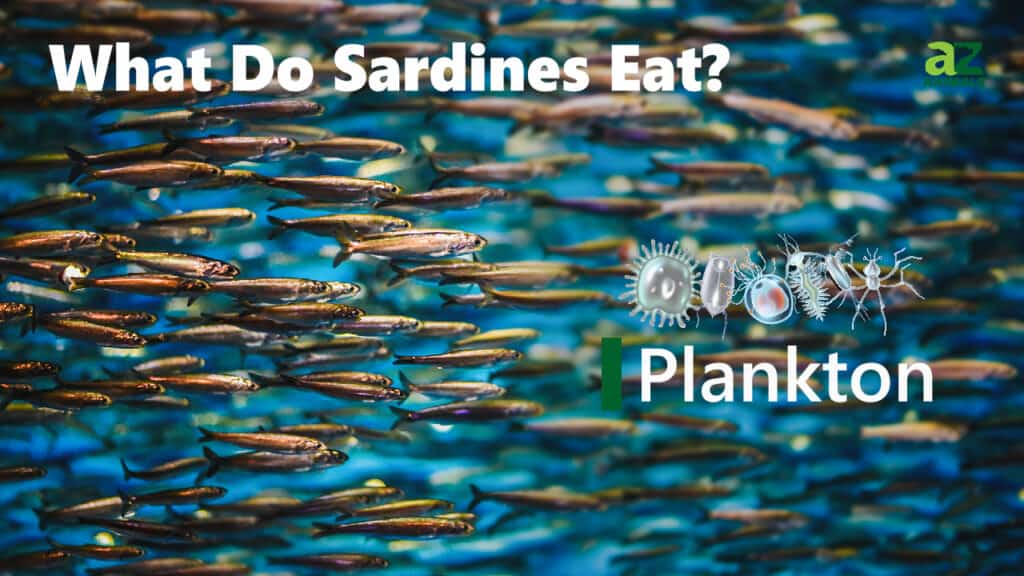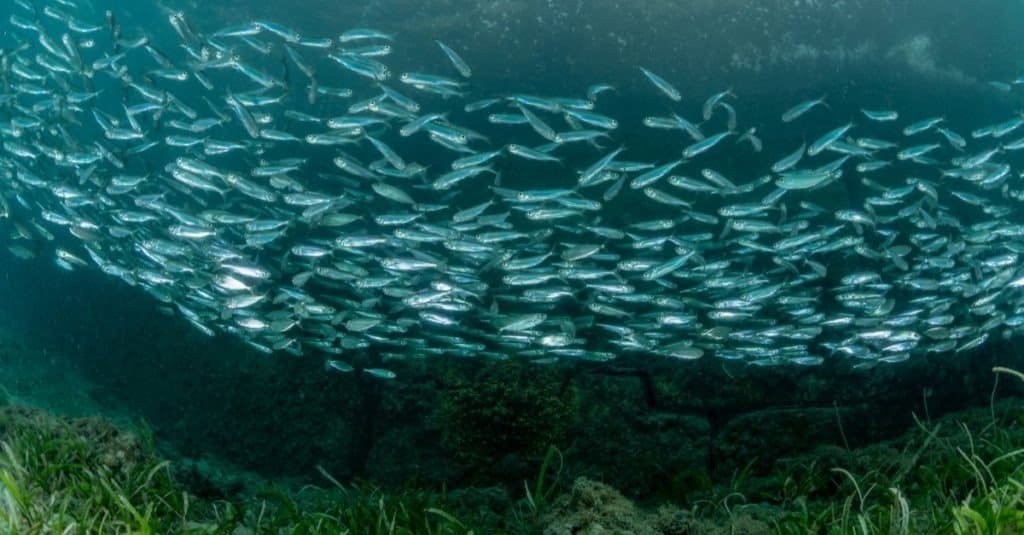Sardines are a group of tiny and oily fishes with small teeth who belong to the Herring Family-Clupeidae. They consist of five distinct genera and 21 species. They are found in abundance in Sardinia, the islands of Italy. That’s why they’re called sardines. They’re actually the common canned fish humans normally snack on.
You may never have tasted sardines before, let alone being aware of their existence. But after giving it a try, you might end up wanting to eat sardines over and over! Now you have an obvious answer on what eats sardines; that’s you! Of course, humans are not the only creatures who feed on sardines. They’re quite a number of species that eat sardines.
How about what sardines themselves eat? What’s their favorite food? How much do they eat?
This article will give you some insights about sardines’ diet and their predators to help you understand them and their major contributions to the ecosystems they live in.
What Do Sardines Eat?

Sardines eat a diet that consists of crustacean eggs, algae, diatoms, and other foods. They are predominantly omnivores since they eat both zooplankton (animals) and phytoplankton (plant) species. Plankton is a collective name for animals and plants that live and thrive in the waters. Sardines eat different forms of plankton from floating eggs to tiny creatures.
Here are some of the varieties of plankton that sardines eat:
- Bacteria
- Coelenterates
- Mollusks
- Protozoans
- Decapods
- Baby barnacles
- Fish eggs
- Dinoflagellates
- Copepods
- Desmids
- Sardinops
How Do Sardines Obtain Food?
Sardines are filter feeders. They filter water through their gills, capturing any plankton that goes through. They make use of their exceptional eyesight and large eyes to trace and increase the number of prey that they filter in water.
Sardines are able to digest these microscopic floating plants and animals as they float through. It may not seem like much is going on during that particular moment, but a single drop of seawater contains millions of microorganisms that you cannot see with your naked eyes.
What Are Sardines Favorite Food?

Sardines eat depending on their body weight, environment, and food availability.
©Dennis Forster/Shutterstock.com
Sardines enjoy eating zooplankton, but they are opportunistic eaters. So, they will also eat phytoplankton whenever they get a chance to. According to research carried out by Marine Ecology Progress Series, 90% of the dietary contents of sardines consisted of zooplankton. Their most important prey is made up of crustacean eggs, dinoflagellates, cirripedes, decapods, copepods, and fish eggs.
How Much Do Sardines Eat?
The amount of food that sardines eat depends on their body weight, environment, and food availability. Depending on food availability, sardines eat about 2% to 5% of their body weight per day.
How Does the Diet of Sardines Impact Other Species?

Sardines are an important species that helps control the populations of plankton in their environments.
©paul cowell/Shutterstock.com
Sardines play a key role in the ecosystem. They’re very important in maintaining the delicate balance of the complex food chains and food webs. As the saying goes “every species in our surroundings is connected to each other” and sardines play a part in this connection.
It’s our duty as humans to protect the populations of sardines together with other species who live in the same ecosystem. I believe we can do so through sustainable fishing and the prevention of marine water pollution. Sardines both control not only help control the populations of plankton but are also an important food source to a number of larger predators.
What Eats Sardines?
Sardines are hunted by a number of predators. Even jellyfish can eat larvae and eggs of the sardines! The following are some of the most common predators who are always on the lookout for sardines.
- Dolphins
- Penguins
- Pelicans
- Terns
- Sharks
- Whales
- Seals
- Mackerel
- Candacia
- Hake
- Loggerhead sea turtles
- Blue butterfish
Many seabirds love to watch out for sardines since it’s a delicious snack for them. They use different strategies to get into the water, such as diving or grabbing sardines from the water surfaces.
Humans can also have a significant impact on sardine populations. As you’ll read below, they’re a popular food in many countries that’s commonly canned.
Is It Okay to Eat Sardines?

Sardines are an excellent source of omega-3 fatty acids and other essential minerals.
©divedog/Shutterstock.com
It’s okay to eat sardines. They are an excellent source of nutrients that help in the prevention of a number of health conditions in humans. They are fully packed with omega-3 fatty acids and other essential minerals and vitamins. This is why sardines are normally recommended for older adults and pregnant women. You only need to consume them while they are still fresh or canned since they are perishable.
What Do Baby Sardines Eat?
Baby sardines eat the same diet as their parents, but they mostly rely on phytoplankton for survival. They eat crustaceans, especially their yolk sac whenever there are insufficient plant species. Baby sardines progress to eating bigger organisms as they grow bigger. In the meantime, they may pick parasites off other fish, or peck other debris in the water.
Final Thoughts
The word sardines is normally used by most people to refer to many fishes. However, the European Pilchardus (Sardina pilchardus), are the true sardines we have been discussing. They inhabit the Northeast Atlantic, the Black Sea, and the Mediterranean. The Journal of Sea Research, highlights that sardines do not eat anything other than plankton. They mainly rely on zooplankton and phytoplankton for survival. As a result, sardines play a key role in their natural ecosystems because they have quite a lot of impact on the population of many other species.
I hope this inspires you to begin advocating for sustainable and more responsible ways of harvesting sardines to maintain their populations in the water bodies.
The photo featured at the top of this post is © flyingv3/Shutterstock.com
Thank you for reading! Have some feedback for us? Contact the AZ Animals editorial team.






